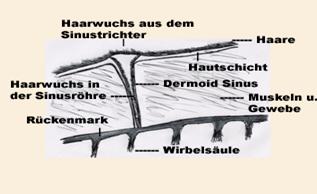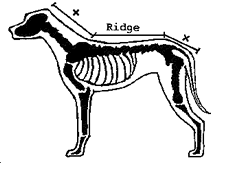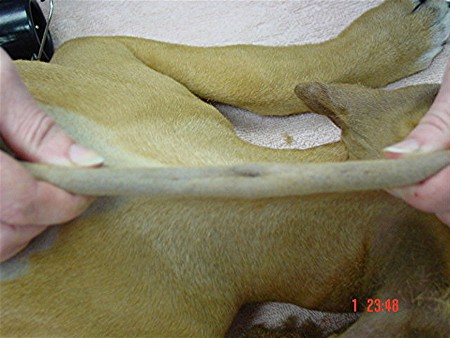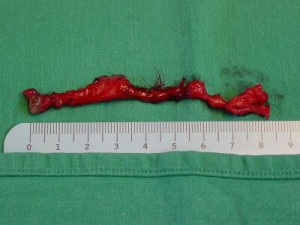The dermoid sinus (DS)
Occurrence:
The dermoid sinus (abbreviated DS) is a cyst, which the ridge is found in dogs primarily.
These include the Rhodesian Ridgeback and Thai Ridgeback.
However, in rare literature from other races reported (eg Dt. Boxer), which under a
Dermoid sinus cyst ill. Likewise, man can be affected.
The shape of the dermoid sinus disease can be viewed as race-specific;
because the frequency of dermoid sinus in the Ridge-dogs to count is an appearance of.
Furthermore, genetic defect are considered one of, because usually the
of knowingly DS-makers to defect or descendants in turn pass on (recessive).
|
A DS is the fact that in embryonic development the cells which later form the skin once, completely separated from those cells are not quite what the nervous system form later. This results in channel-like structure of the skin, which gives the skin surface down to the spinal column from pulling.Within these channels skin is fully formed with hair and skin glands occurring (eg, sebaceous glands).
|
DS-description:
From the outside is often just a small point-like skin changes or additional vortices in the hair growth can be seen best one. Depending on the size (diameter of the DS channel: Thin as a "thread", "spaghetti Dick" to the diameter of a pencil, etc) is by scanning the skin a deep tissue leading strand to be felt in the. Dermoid sinus transgress primarily along the midline of the neck, in the dome (loin) or the tail (see chart). If the DS is not surgically removed, it is usually sooner or later an infection. This is the accumulation of skin and hair particles, dirt, grease and moisture in the DS-channel triggered by.If a DS channel is a spreading infection in, it can cause swelling and / or to the escape of wound fluid to come out.In the worst case, the infection to the depth of the spinal cord migrate, neurological problems and / or sepsis (blood poisoning) cause, which if untreated leads to death of the animal.

DS-finding:
A dermoid sinus channel is present at birth and can not be formed later.
The DS-strand grows with the puppy, he is no more cords, extensions, etc. Dermoid sinus in newborn puppies is usually difficult to diagnose because the channel / strand outside often do not or is not visible.Scanning of the puppy (dog) was diagnosed. This skin will be slightly raised and passed slowly between his fingers.Is a slight resistance, a cartilage or thread-like structure to sense can be considered one of DS. For several years there by Rhodesian Ridgeback associations already several projects to develop a gene test and thus the precise determination of DS via mass-seeking gene which. To date, however, there is no proven method.


Next steps / OP:
As in the chapter "appearance" is mentioned, not necessarily the health conflicts directly with the DS, but by the DS caused further complications such as the previously described infection of the channel.It is advised by some experts, the "silent DS (DS not inflamed) to rest and watch as long as can be, as it is anerbietet. However, this is fraught with the risk that a possible infection, and only discovered to be ignored if it is already well advanced. It can be advised, a DS channel after his find, but not earlier than the 8th Week of life, can be removed surgically by a specialist.The procedure for this operation is primarily the exact classification of the location and size of the DS, which elicited a by x-ray.The subsequent course of operation consists of the clean removal of the DS-strand and the post on the possible infection of the operating field.Depending on the size of the DS-channel and the different costs vary accordingly the expenses for the procedure, but it can by a frame between 300, - are spoken uro - and € 600. The forecast is properly performed surgery great, the dog usually recovers completely and it must not, with sequelaebe expected. Back there is often a visible scar (from case to case size and visible) and / or additional cowlick which animal but in no way affect that. It can lead a normal life.

Conclusions for the breeder and the buyer:
The breeder should be exhorted to be open and honest with the subject of dermoid sinus in the litters
deal with it. Often the breeders feared that by a DS-carrier in the litter its breeding, the
Breeding female per se and / or the stud dog is brought into disrepute. The subsequent "cover-up" of the
DS cases leads in the race too far serious injury and in no way a convenience to
Breeding goal! The puppy buyers are advised to check the DS of the throw to inform themselves (who made it) and the right to give the puppy BEFORE the purchase by a specialist
can be controlled. addition, a written agreement made with the breeders, which regulates precisely
that the cost of a DS-operation in any case (even after the puppy adoption and an unlimited
Time) at the expense of the breeder fall.
The decision on a DS carrying puppy / young dog, despite
the previous medical history will be made, insofar as the buyer are not breeding
Ambitions with the dog entertainsand conditions with regard to possible costs to the farmers clear the
geregelt sind. regulated.
Even in the case of a previously operated DS-dog the buyer should secure written
that which was caused by, the operation to the detriment of the breeder fall complications. Bei In
Dogs used DS-carrier siblings have, must be weighed, whether they enter the breeding
should not. The breeder should be aware that this DS for a recessive disease is the
and therefore dogs that DS direct relatives have bearing, risk-bearing are. The breeder is
It must decide whether they will be labeled "not suitable for breeding 'pedigree can add one in (by the
Dog Association) or not.
Prepared by the Rhodesian Ridgeback breeders:
Mashambani

& Mhangura
